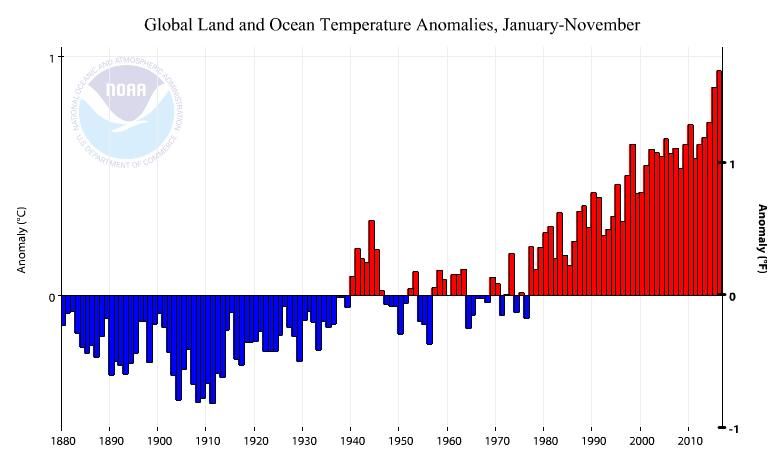

By Jeff Masters
November 2016 was Earth’s fifth warmest November since record keeping began in 1880, said NOAA’s National Centers for Environmental Information on Monday.
November 2016 was 0.7 C (1.31 F) warmer than the 20th-century November average, but 0.23 C (0.41 F) cooler than the record warmth of 2015. NASA reported that November 2016 was the second warmest November in its database, behind November 2015. The difference between the two data sets is, in large part, due to how they handle the data-sparse areas in the Arctic, which was record warm in November. NOAA does not include most of the Arctic in their global analysis, while NASA does.

Figure 1. Departure of temperature from average by region for November 2016, the fifth warmest November for the globe since record keeping began in 1880. Record warmth was observed across parts of central and southeastern Canada, some areas across the far northern tier of the U.S. along with a portion of the southwest U.S., parts of western and southern Mexico, sections of eastern and west central Africa, a few parts of northern South America, and regions of some southeastern Asia island nations. Cooler-than-average conditions were observed across much of the central Eurasian continent, with monthly temperatures at least 5 C (9 F) below average in central Russia and parts of northeastern Asia. In South America, central Bolivia experienced record cold temperatures during November.
A weak La Niña event is now underway in the Eastern Pacific and the cool waters present there have helped cool the planet slightly below the record warm levels observed during the strong El Niño event that ended in May 2016. The fact that November 2016 was still the 2nd to 5th warmest November on record despite the presence of La Niña can mostly be attributed to the steady build-up of heat-trapping greenhouse gases due to human activities.
NOAA’s global surface temperature for the year so far (January-November 2016) is an impressive 0.94 C (1.69 F) above the 20th-century average and 0.07 C (0.13 F) warmer than the previous January-to-November record, set in 2015. Remarkably, no continental land areas were cooler than average for the year-to-date. It is almost certain that 2016 will end up as the warmest year on record for the planet, giving Earth three consecutive warmest years on record.
Ocean-Only, Land-Only, and Lower Atmosphere Temperatures in November
Ocean-only temperatures this November were the second warmest on record, while land-only temperatures were the 12th warmest on record. (Since most of Earth’s surface is covered by ocean, the land-plus-ocean reading is dominated by the ocean-only temperatures, thus keeping November 2016 so warm globally). For the lowest 8 km of the atmosphere, global satellite-measured temperatures in November 2016 and for the January-November year-to-date period were the warmest in the 38-year record, according to the University of Alabama in Huntsville. For the stratosphere, the year-to-date temperatures were the coldest on record. Stratospheric cooling is a classic symptom of an increase in greenhouse gases in the atmosphere—the upper atmosphere must cool to compensate for warming near the surface.

Figure 2. Departure from the 20th-century average for the global January-through-November temperature for the years 1880 – 2016. This year has seen by far the warmest temperatures on record for the year-to-date period.
Arctic Sea Ice Hits Its Lowest November Extent on Record
November 2016 Arctic sea ice extent was the lowest in the 38-year satellite record, according to the National Snow and Ice Data Center (NSIDC). The record low was due to unusually high air temperatures, winds from the south and a warm ocean. For a brief period in the middle the month, total extent actually decreased by 50,000 square kilometers (9,300 square miles.) The only other November retreat of Arctic sea ice in the 38-year satellite record was a less pronounced and brief retreat of 14,000 square kilometers (5,400 square miles) that occurred in 2013. Seven of the eleven months of 2016 have seen record-low Arctic sea ice and the annual sea ice minimum in September was the second lowest on record.
https://twitter.com/EcoWatch/statuses/799927739507675136 at Terrance B. Lettsome International Airport.
- Iraq: July 22, 53.9 C (129.0 F) at Basrah.
- Iran: July 22, 53.0 C (127.4 F) at Delhoran (tie.)
- Kuwait: July 21, when the mercury hit 54.0 C (129.2 F) at Mitribah.
- Guernsey (United Kingdom territory): July 19, 35.0 C (95 F) at the small island of Alderney (tie.)
- Hong Kong Territory (China): July 9, 37.9 C (100.2 F) at Happy Valley (tie.)
- Niger: June 8, 49.0 C (120.2 F) at Bilma.
- Palau: June 8, 34.4 C (93.9 F) at Koror AWS (tie.)
- India: May 19, 51.0 C (123.8 F) at Phalodi.
- Maldives: April 30, 35.0 C (95.0 F) at Hanimaadhoo.
- Thailand: April 28, 44.6 C (112.3 F) at Mae Hong Son.
- Cambodia: April 15, 42.6 C (108.7 F) at Preah Vihea.
- Burkina Faso: April 13, 47.5 C (117.5 F) at Dori.
- Laos : April 12, 42.3 C (108.1 F) at Seno.
- Vanuatu in the South Pacific: Feb. 8, 36.2 C (97.2 F) at Lamap Malekula.
- Tonga: Feb. 1, 35.5 C (95.9 F) at Niuafoou.
- Wallis and Futuna Territory (France): Jan. 10, 35.8 C (96.4 F) at Futuna Airport.
- Botswana: Jan. 7, 43.8 C (110.8 F) at Maun.
Hong Kong Territory (China) set its all-time coldest mark on Jan. 24, -6.0 C (21.2 F) at Tai Mo Shan (elevation 950 meters). Tai Mo Shan has a period of record going back to 1996; the coldest temperature near sea level since record keeping began at the Hong Kong Observatory in 1884 was 0 C (32 F) on Jan. 18, 1893.
Reposted with permission from our media associate Weather Underground.

 233k
233k  41k
41k  Subscribe
Subscribe 